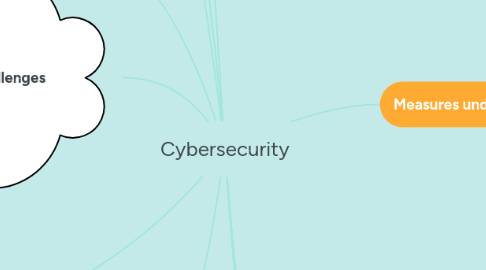
1. Cloud Computing Strategy
2. Need of cybersecurity
2.1. Confidentiality
2.2. Integrity
2.3. Availibility
2.4. Privacy
2.5. Security
3. Types of cybersecurity
3.1. IT security
3.2. Application security
3.3. Cloud Security
3.4. Network Security
3.5. Critical Infrastructure Security
3.6. Internet of Things Security
4. Challenges
4.1. Cloud Vulnerabilities
4.2. Internet of Things
4.3. Phishing
5. State emergency response plan
5.1. Risk and resuilience
5.2. Co-ordination and response
5.3. Relief and recovery
6. Current State Key initiatives
6.1. Managing Cybersecurity Throughout the Enterprise
6.2. Understanding Data Assets and Threats
6.3. Building the Federal Cyber Workforce
6.4. Promoting the Use of Standardized, Centralized IT
6.5. Securing the Network
6.6. Securing Authentication and Authorization – Identity, Credential, and Access Mgmt.
7. Threats
7.1. External
7.2. Internal
7.2.1. Threat Intelligence
8. Benefits
8.1. Long term
8.1.1. Reducing Cybercrime
8.1.2. Ciustomer Satistfaction
8.2. Short term
8.2.1. Safegaurding data
8.2.2. Increased search engine rankings
9. Measures undertaken
9.1. Risk determination
9.1.1. Risk report
9.1.1.1. Threat awareness
9.1.1.2. Standardize IT and cybersecurity capabilities
9.1.1.3. improve incident detection and response capabilities
9.1.1.4. Drive accountability
9.2. Continuous Monitoring
9.2.1. CONTINUOUS DIAGNOSTICS AND MITIGATION (CDM)
9.2.2. NATIONAL CYBERSECURITY AND COMMUNICATIONS INTEGRATION CENTER (NCCIC)
9.3. Federal Acquisitions
9.3.1. Security Controls
9.3.2. Cyber Incident Reporting
9.3.3. Information System Security Assessments
9.3.4. Information Security Continuous Monitoring
9.3.5. Business Due Diligence
9.4. HVA Process
9.4.1. Plan
9.4.1.1. Stakeholder engagement
9.4.1.2. Business process review
9.4.1.3. Governanace
9.4.1.4. Engagement with third party
9.4.2. Identify
9.4.2.1. Agency specific assessment
9.4.2.2. Threat intelligence
9.4.3. Categorize
9.4.3.1. Determine physical location
9.4.3.2. Determine Key stakeholders
9.4.3.3. Communicate roles
9.4.4. Priortize
9.4.4.1. Risk matrix of threat
9.4.5. Report
9.4.6. Assess
9.4.6.1. Pre-Assessment
9.4.6.1.1. Identify system dependencies and interdependencies
9.4.6.1.2. Conduct security assessments of HVAs
9.4.6.1.3. Appropriate agreements and assessments
9.4.6.2. Assessment
9.4.6.2.1. Risk and Vulnerability Assessment (RVA)
9.4.6.2.2. Security Architecture Review (SAR)
9.4.7. Remediate
9.4.7.1. Remediation Plans
